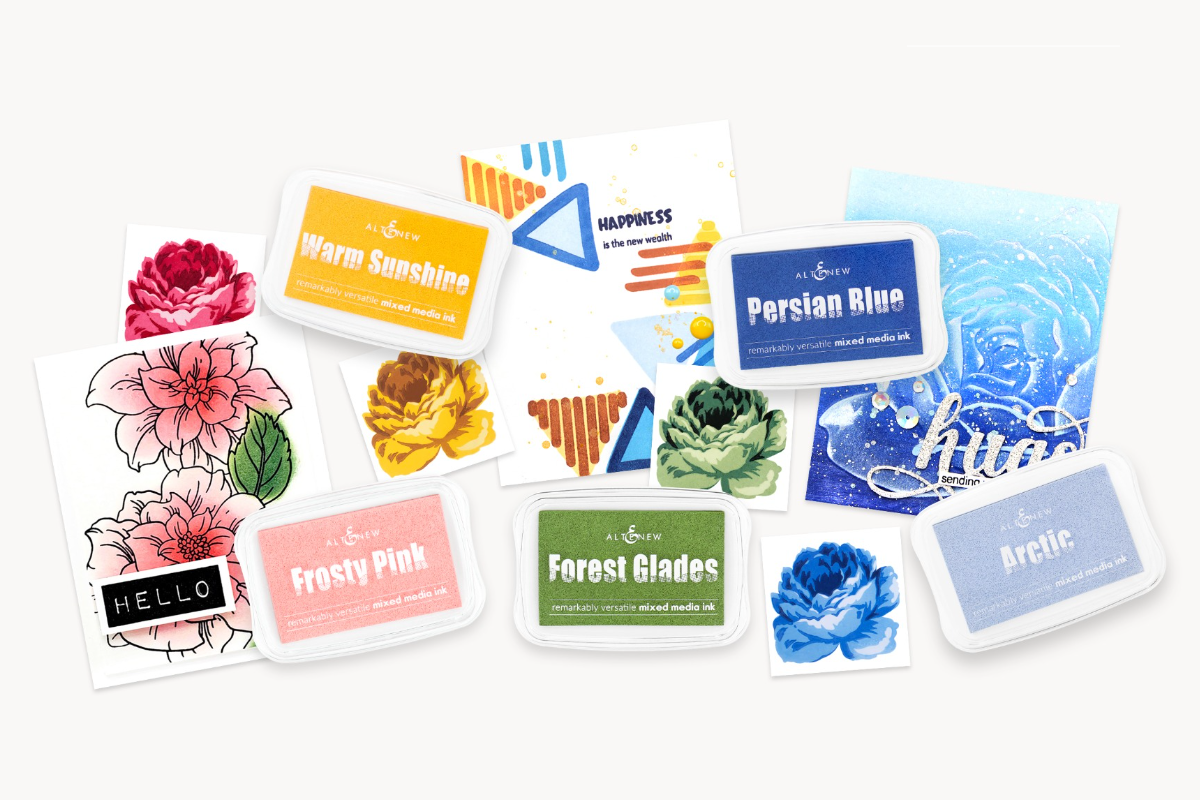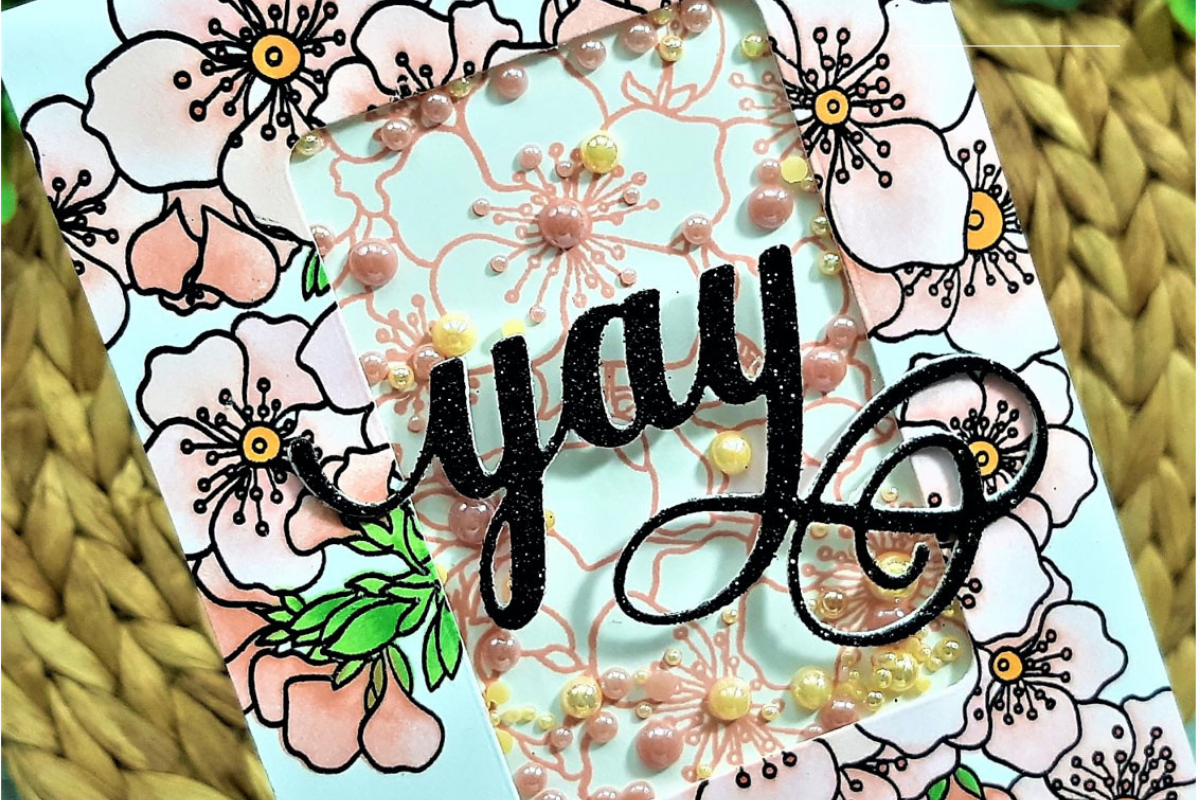Are you looking for the best ink to use for different paper crafting projects? Or perhaps you're torn between choosing pigment ink or dye ink? Look no further! Today, we'll discuss the key differences between pigment ink vs. dye ink, what is pigment ink, and what are the features, pros, and cons to using these different types of inks for paper crafting.

From Summer to Winter Pigment Ink Bundle
What Is Pigment Ink?
Pigment-based ink is a type of ink used to color paper and other surfaces. Pigments are tiny particles of solid matter suspended in a liquid or gas medium, such as water or air. In this case, the pigment is mixed with an oil-based carrier. This type of ink has been around for centuries and was originally made from natural pigments like those found in plants, animals, and minerals.
Unlike water-based inks, pigment inks are water-resistant and more fade-resistant. They can be a great way to add color, texture, and vibrancy to your cards, scrapbooks, journals, and other paper crafts. Commonly, they are used in mixed media art and watercoloring projects.

Rich, Crisp, and Smooth Pigment Inks
What Is Pigment Ink Made Of?
Pigment ink combines water, pigment, resin, and other additives to create durable and high-quality ink. Depending on the desired outcome, the ink may be heated or cooled during its creation process.
It's the go-to ink for printing on textiles, packaging labels, and other specialty applications where durability is critical. However, it's not just limited to these uses - it's also utilized in advanced industrial printing systems, digital textile printers, and direct-to-fabric printer models. So the next time you see a beautifully printed fabric or printing project, you can appreciate the magic of pigment ink!
In addition, one of the reasons pigment ink is so powerful is because of its oil-based pigment components. This makes it easy to use on multiple crafting projects. While there are different types of pigment-based inks available today, each type shares the characteristic of being water-resistant and fade-resistant over time.

What Is a Pigment Ink Pad?
In paper crafting, using a pigment ink pad is nothing new. This water-proof ink is opaque, vibrant, and ideal for heat embossing techniques. It’s the perfect ink for heat embossing techniques because it sits on top of the paper and doesn’t absorb into it. It also takes longer to dry. These inks are more spongy and foamy compared to a dye ink pad. It is thicker and richer, and more fade-resistant.
Ready to Become an Ink Expert? - Learn More Here!
What Is the Difference Between Pigment Ink and Dye Ink?
If you’re new to stamping and cardmaking, you’re probably confused about the difference between pigment-based inks and dye-based inks. What is the best ink for cardmaking? Which one should you invest in? The answer will surprise you - get both! It’s hard to compare the two inks without highlighting some of their excellent features. Both inks offer a lot of benefits for different projects. As a cardmaker, crafter, or scrapbooker, you will be trying various techniques and need both types of ink to create beautiful and unique crafts.
The most notable difference when talking about pigment ink vs. dye ink, other than the formula, is that while the latter ‘dyes’ the surface, the former sits on top of it.

What Is Dye Ink?
Most stampers will tell you that dye-based ink is the best ink for stamping. Dye-based ink is vibrant, translucent, acid-free, fast-drying, and fade resistant. It works well with various kinds of paper and pairs perfectly with rubber stamps and clear photopolymer stamps. Since the color substances are dissolved in a liquid, they absorb into the paper and don’t sit on top like a pigment ink pad.
If you want to know the main differences between using pigment inks and dye-based inks, refer to the table below:
|
Type of Ink |
Features |
Pros |
Cons |
|
Pigment-based ink |
|
|
|
|
Dye-based ink |
|
|
|
Benefits of Using Pigment Ink vs. Dye Ink
Pigment inks are incredibly versatile inks that can be applied to a broader range of fabrics than dye-based inks, including polyester and nylon. This makes them the preferred choice when creating custom textile items such as purses, tote bags, pillowcases, or t-shirts.
They also provide better color accuracy than dye-based inks because they dry quickly with less bleeding or smearing when printed onto fabric substrates. Additionally, pigment ink can withstand extremes of temperature and humidity, making them ideal for use under various environmental conditions.

Green Fields Pigment Ink Bundle
One of the significant benefits of pigment-based ink is that it is waterproof. This means that you can use it to print on fabrics for outdoor clothing, use it for watercoloring cards, stamping on shrink plastic, and more.
Another benefit to using pigment inks is that they are more water-resistant than dye inks. The ink will "bead" up when you overlay an area with water instead of sinking into the fibers like dye-based inks would do. This means you won't have to worry about the ink bleeding when printing on cardstock or cardboard items.
However, one disadvantage is that pigment ink pads are more expensive than dye-based inks because of their added resin content. Resin, a more costly material, helps them hold up better on thicker items like paper, cardstock, fabric, and plastics. Another potential downside is that it takes longer for the ink to dry on the surface than it would with other types of ink.
Elevate Your Projects With These High-Quality Inks!
What Is the Best Ink for Cardmaking?
The simple answer is: it’s still a personal preference that depends on the type of project you want to work on. Just remember, not all inks are created equal. Do your research and find one that suits not just your budget, but your crafting needs as well!
In the battle of pigment ink vs. dye ink, the former offers many advantages over the latter because it renders well to a wide variety of techniques and mediums. Pigment ink might be a bit pricier than dye inks, but their durability and quality are unmatched.

When buying pigment inks, you need to remember the different types of pigment-based inks available on the market, including solvent-based, water-based, or oil-based. The solvent-based pigment ink pad is by far the most popular and can be used with different types of fabric and other surfaces, such as paper and plastic.
Uses of Pigment Inks In Paper Crafting
What makes pigment ink pads a must-have for paper crafters? Not only are they versatile, but they can also be used in a wide range of DIY crafting projects: from handmade cards and scrapbook pages to personalized t-shirts! Yes, you read that right! These water-based inks can be used to stamp gorgeous and unique designs on different types of fabric such as cotton, canvas, and linen.
Here are 9 things you should know about Altenew’s line of pigment-based inks!
- You can use them on various porous surfaces, such as paper, fabric, wood, cork, and more!
- These inks are more opaque and provide beautiful coverage.
- Since they are water-based, they will leave a gorgeous detailed impression every single time.
- You can set the stamped image with a heat gun or iron to make it permanent.
- These pigment inks are rich, vibrant, and acid-free!
- These inks are archival so your handmade projects will last for a long time without fading.
- They’re perfect for multiple card making techniques such as stamping, ink blending, heat embossing, and stenciling!
- You can use them on dark cardstock or dark surfaces!
- There’s a range of color families to choose from, and they coordinate with the rest of our ink line!

12 Fun DIY Paper Crafts You Can Make With Pigment Ink
- Handmade cards
- Scrapbook pages
- Art journal cover
- Bullet journal page
- Mixed media art
- DIY home decor
- Gift boxes
- Personalized t-shirt
- Handmade tags
- DIY bookmarks
- Customized pillowcase
- DIY canvas drawstring bag

All in all, pigment inks are a must-have for any paper crafting project. It is your best option if you’re looking to make cards, scrapbook pages, or mixed media art pieces with impressive color and texture.
You can use these multi-purpose inks can be used on most surfaces, including watercolor papers, wood veneers, fabric, and more - leaving room for endless creative possibilities!
The best part is that, you can also blend pigments into each other using tools like sponges or ink blending brushes, creating an endless number of unique colors that you won’t find anywhere else. If you’re a beginner who wishes to explore different techniques and ideas using these versatile ink pads, make sure to check out our FREE Crafting 101 Mixed Media Inks online class! So what are you waiting for?

